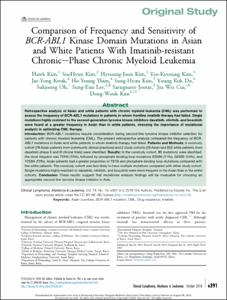KUMEL Repository
1. Journal Papers (연구논문)
1. School of Medicine (의과대학)
Dept. of Internal Medicine (내과학)
Comparison of Frequency and Sensitivity of BCR-ABL1 Kinase Domain Mutations in Asian and White Patients With Imatinib-resistant ChronicePhase Chronic Myeloid Leukemia
- Keimyung Author(s)
- Do, Young Rok
- Department
- Dept. of Internal Medicine (내과학)
- Journal Title
- Clinical Lymphoma, Myeloma & Leukemia
- Issued Date
- 2018
- Volume
- 18
- Issue
- 10
- Keyword
- Asian countries; BCR-ABL1 mutation; CML; Drug resistance; Imatinib
- Abstract
- Retrospective analysis of Asian and white patients with chronic myeloid leukemia (CML) was performed to assess the frequency of BCR-ABL1 mutations in patients in whom frontline imatinib therapy had failed. Single mutations highly resistant to the second-generation tyrosine kinase inhibitors dasatinib, nilotinib, and bosutinib were found at a greater frequency in Asian than in white patients, stressing the importance of mutational analysis in optimizing CML therapy.
Introduction:
BCR-ABL1 mutations require consideration during second-line tyrosine kinase inhibitor selection for patients with chronic myeloid leukemia (CML). The present retrospective analysis compared the frequency of BCRABL1 mutations in Asian and white patients in whom imatinib therapy had failed.
Patients and Methods:
A nonstudy cohort (76 Asian patients from community clinical practices) and 2 study cohorts (29 Asian and 352 white patients from dasatinib phase II and III clinical trials) were identified.
Results:
In the nonstudy cohort, 80 mutations were identified the most frequent was T315I (15%), followed by phosphate-binding loop mutations E255K (11%), G250E (10%), and Y253H (10%). Asian patients had a greater proportion of T315I and phosphate-binding loop mutations compared with the white patients. The nonstudy cohort was less likely to have multiple mutations compared with either study cohort. Single mutations highly resistant to dasatinib, nilotinib, and bosutinib were more frequent in the Asian than in the white cohorts.
Conclusion:
These results suggest that mutational analysis findings will be invaluable for choosing an appropriate second-line tyrosine kinase inhibitor in Asia.
- Keimyung Author(s)(Kor)
- 도영록
- Publisher
- School of Medicine (의과대학)
- Citation
- Hawk Kim et al. (2018). Comparison of Frequency and Sensitivity of BCR-ABL1 Kinase Domain Mutations in Asian and White Patients With Imatinib-resistant ChronicePhase Chronic Myeloid Leukemia. Clinical Lymphoma, Myeloma & Leukemia, 18(10), e391–e399. doi: 10.1016/j.clml.2018.06.031
- Type
- Article
- ISSN
- 2152-2650
- Source
- https://www.clinicalkey.com/#!/content/playContent/1-s2.0-S2152265018304257?returnurl=https:%2F%2Flinkinghub.elsevier.com%2Fretrieve%2Fpii%2FS2152265018304257%3Fshowall%3Dtrue&referrer=https:%2F%2Fwww.ncbi.nlm.nih.gov%2Fpubmed%2F%3Fterm%3D30082224
- Appears in Collections:
- 1. School of Medicine (의과대학) > Dept. of Internal Medicine (내과학)
- 파일 목록
-
-
Download
 oak-2018-1611.pdf
기타 데이터 / 335.74 kB / Adobe PDF
oak-2018-1611.pdf
기타 데이터 / 335.74 kB / Adobe PDF
-
Items in Repository are protected by copyright, with all rights reserved, unless otherwise indicated.